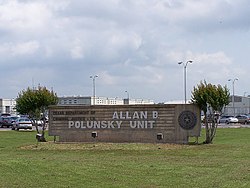Kenneth Foster | |
|---|---|
| Born | Kenneth Eugene Foster Jr. October 22, 1976 Texas, U.S. |
| Known for | Controversial conviction and death sentence |
| Criminal status | Incarcerated |
| Convictions | Capital murder (2 counts) Aggravated assault with a deadly weapon (2 counts) |
| Criminal penalty | Death; commuted to life imprisonment with the possibility of parole after 40 years, later sentenced to life without parole |
| Details | |
| Locations | San Antonio, Texas, U.S. Bowie County, Texas, Texas, U.S. |
Date apprehended | August 15, 1996 |


Kenneth Eugene Foster Jr. (born October 22, 1976) is a prisoner formerly on death row in Texas, convicted under the Texas law of parties. He was convicted as an accomplice to the robbery and murder Michael LaHood Jr. on August 15, 1996, at 2:46 a.m., despite not firing a shot. [1] On that same night, Foster, along with three of his friends, Julius Steen, Mauriceo Brown, and Dwayne Dillard, were driving around San Antonio committing armed robberies. Eventually, the group found LaHood outside his parents' home. From there, Mauriceo Brown exited the car and killed him with a shot to the head. [2] Foster's conviction and death sentence were contested because he was convicted under the law of parties, not for physically committing the crime.
Contents
While Texas law uses the phrase, "law of parties," this concept is simply a form of "felony murder," a ubiquitous legal standard well known in both common law and by statute. 43 of the 50 United States have some form of felony murder. Under felony murder, a person may be criminally liable if the accused causes the death of another person in the course of committing a separate felony. Of the 43 states with some form of felony murder, there are at least four approaches related to variables such as degree of negligence, proof of "malice," or in 28 states proof of a related death and the mere act of committing the separate felony are sufficient. [3]
Foster, Texas Department of Criminal Justice (TDCJ) death row #999232, was received on death row on July 1, 1997. [4] He was initially located in the Ellis Unit, but was transferred to the Allan B. Polunsky Unit (formerly the Terrell Unit) in 1999. [5]